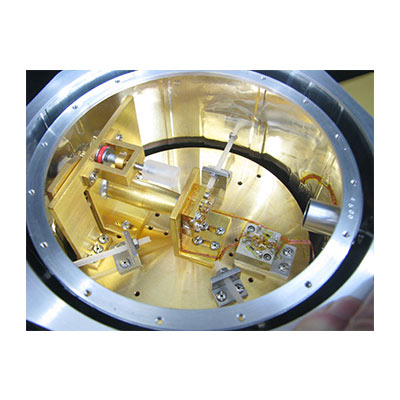Our photoconductors offer advantages to best meet your spectral band, frequency response, noise, budget, and cryogenic or cryogen-free cooling requirements. We have decades of experience customizing configurations to meet your specific application requirements including longer hold times, increased work height, dual detectors, filter positions, coupling options, and more.
Photoconductor Table
Spectral Response (µm) | Operating Temp (K) | Electrical Sensitivity (S[V/W] | Noise Equivalent Power [W/Hz(1/2)] | Noise Vn[nV/Hz(1/2)] | Frequency Response (Optimum Chopping Frequency) | Liquid Cryogen Cooling | Cryogen-free Cooling | |
|---|---|---|---|---|---|---|---|---|
| Si:B Photoconductor | 5 – 30 | 4.2 | SNR > 2.5 X 105 | < 5.0 X 10-12 | < 20µV/Hz(1/2) at 1kHz | DC to 5kHz | ||
| Ge:Ga Photoconductor | 40-120 | 4.2 | SNR > 2.5 X 105 | < 5.0 X 10-11 | < 10µV/Hz(1/2) at 1kHz | DC to 5kHz |
What is a photoconductor?
Photoconductors function by absorbing a photon that has energy greater than that of the bandgap energy of the semiconductor material. The energy of the photon breaks a bond and lifts an electron into the conduction band creating an electron/hole pair that can migrate through the material and conduct a measurable electric current. IRLabs offers photoconductors made of either Boron doped Silicon or Gallium doped Germanium. These detectors cover the spectral range between 5-30um and 40-120um, respectively.
Cooled using liquid cryogens or mechanical refrigeration.
Photoconductors are cooled to cryogenic temperatures using pour-filled liquid cryogen dewars or cryogen-free mechanical refrigeration. Liquid cryogen coolers are compact with no moving parts, easy to use, have a lower initial cost, and recommended for simple, reliable operation. Refrigerated systems are larger, more complex, and have a higher initial cost but eliminate the expense of refilling cryogens. Cryo-free cooling is recommended for cost-effective, continuous unattended cold operation:

